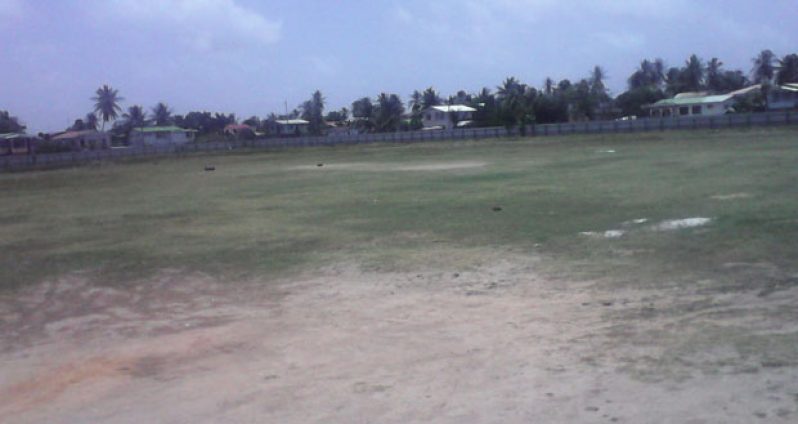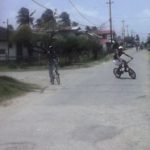OUR NEXT STOP was at a quaint little village that looks quite simple and sometimes desolate from the outside, but has quite a story to tell the moment you venture inside.Well here I was in Better Hope, on the East Coast of Demerara, interacting and chatting with villagers as the broiling midday sun scorched me with its intensity; and, yet again, I had forgotten to take an umbrella with me. Well…,the work has to be done, and I certainly wouldn’t die from a little sunburn, given the fact that I was a hard core ‘country bred kid.’
Better Hope is located some twelve miles from the city of Georgetown. It is sandwiched nicely between the busier villages of Vryheid’s Lust and Plaisance. With a population of over 2,000, the village, over the years, has been known to be among the most popular in producing much hyped and exciting sports and entertainment activities.
Since it was very early in the afternoon, we were greeted with the gleeful laughter of a few young girls playing hop-scotch on the main dam leading to the cluster of houses just a short distance ahead.
Somewhat surprised at our entrance, the little ladies looked up sharply. Sweeping us up and down, their eyes locked onto my pen, writing pad, camera and media identification card. This, I believe, prompted the soft, pleasant greetings of “Good afternoon, sir,’ before they went back to their games, glancing at us every now and then in childish curiosity.
Stopping to chat with residents at the first house, a few males raised questioning eyebrows, but the two females there were all welcoming smiles. One who appeared to be a grandmother mouthed with a toothless grin: “Good aftanoon uncle… wha wrang? How awe can help yuh?”
Instantly, my soul was at ease, and with responding warmth, I went into detailed explanation of the reason for my visit. Hearing this, the males seemed to get excited, and two of them readily smoothed and fixed their apparel, offering to give us the grand tour of the small village.
BETTER HOPE IN TIMES GONE BY
As luck would have it, I bumped into just the man I wanted to speak to. He prefers to be called ‘Robbie’, as he is popularly known throughout the village.
Actually, the smiling gentleman was back from the USA to try his best at resuscitating sports and entertainment in the village, which was disappearing for one reason or the other. An elderly resident of the village, he was more than elated to shed light on the infrastructural layout of the village before it took on its present-day appearance.
According to ‘Robbie’, Better Hope was a small settlement more known for its plush, open pastures and country-style houses scattered across the village. It was the land where large crowds gathered in the pastures, especially at weekends, for endless open-air parties and sporting events of all sorts.
At Easter time the Better Hope seawall was the preferred location for kite flying, picnics, and even jolly boat racing among residents and outsiders. The inter-bloc sports competitions were a major item on the itinerary, and residents looked forward to their staging, and this involved varying sports clashes between teams in the village and outside groups that dared to put up a fight.
This village reputedly had one of the best soccer teams, vibrant cricket teams, and had produced talented players in Narine Ramroop and ‘James’, who have since migrated to the proverbial greener pastures.
Robbie told tales of bonfire storytelling and athletic females who were ready to defend their titles at circle tennis. Today such characteristics are almost non-existent, and Robbie explained why: Better Hope, is times gone by, was a vibrant fishing village; but from interviews there, it is evident that parents are deterring their young ones from engaging in that trade, and are urging them to seek more ‘modern’ forms of employment and a proper education.
At one time, most of the residents were employed at nearby sugar estates, but even this practice has disappeared; and, to date, there are just about three young men in the village who are sugar workers.
In years gone by, Better Hope had the appearance of a very quiet settlement, with just a demure simplicity to its existence. While houses were scattered in no particular order, the abundance of fruit trees and bush foliage, coupled with the ever-ready smiles of residents as they toiled relentlessly to put food on the table, had, for some strange reason, added a distinct allure to the village.
Very few shops were located in the village, and those provided limited grocery supplies, but that never bothered residents, since catching fish and, to some extent crabs, was the ‘in thing’ for most families, thus not only providing added food choices, but also paved the way for another source of livelihood.
Farming was also another significant occupation, and some had thrived on this, since they could have marketed their produce in nearby villages and also in the city. Soon more shops began to pop up in the area, many of them well established businesses, as the village gradually began to wear its prized coat of modernisation.
Eventually, a few stores, groceries, Internet cafes’ and many entertainment hot spots emerged. The low and muddy areas in the village soon became very busy and populated zones as persons began erecting houses in the blink of an eye. Many spent their hard-earned dollars and did work on the under-developed lands, building plots to perfection to accommodate houses, shops and other structures.
ROBBIE SPEAKS OF CHANGING CULTURES
“Returning to the village after 19 years, I have noticed that there is a distinct change in the culture we enjoyed long ago. I can remember growing up as a young boy when the playground was managed by ‘Bookers.’ Everyone played on that field as they wished, and nothing prevented them… Older folks were more involved too, in sports and entertainment, and this accredited the village its popularity.
“Now there seems to be a high level of neglect in such areas, and persons have not taken up the mantle left by older sports and entertainment enthusiasts. While at one time we had the best football team on the East Coast of Demerara, I return to a playground where there are no goal posts, and the memories of the glorious sporting days are now gone,” Robbie said forlornly.
Another factor that has contributed to the decline of sports in the village is the migration of sporting icons, but Robbie and a team of other individuals, inclusive of overseas-based Randolph Subryan, are doing everything they can to resuscitate sports in the village.
Last Tuesday, coaching began for the 15-to-19 football team, which has occupied centre stage since September last year. Through diligent fund-raising efforts, those behind the drive have managed to secure some $600,000, which are to be utilised to purchase gears and other items for the football team. Team members were presented with their items just recently by the Minister of Culture, Youth and Sports, Dr. Frank Anthony.
Presently, the village is focusing on giving guidance to junior footballers, and a female National Football Coach is working along with a few youngsters from the village. There are plans for similar ventures in the areas of basketball and cricket, and so far, the basketball court in the village has been repainted.
However, this sport poses some challenges, since it seems not to be generating much interest among the youths. All of this, of course, would be done in collaboration with the NDC body in the village.
BRINGING BACK THE OLD
It is the intention of prominent villagers to bring back ‘the things of old’, to restore that special ‘yesteryear sparkle’ to the village; and to top things off, plans are ongoing to bring back the Senior Citizens Party’ after a five-year hiatus.
This party was hosted last December, and it was a great success. And again, Robbie and other public-spirited individuals distributed gifts to the children of the village, who received the tokens with much joy and enthusiasm.
There are also plans to bring back the ‘Better Hope Games’, which actually is a festive fusion of various sporting contests. These were quite a treat for residents.
To keep the ground in perfect shape, the group headed by Robbie has, so far, managed to spend $150,000 in acquiring dirt to fill holes that have developed on the playfield. Work on a volleyball court is among the plans, so as to ensure this location becomes a dual sporting facility.
Members of the Better Hope community have always maintained close fraternal relations, as though the village were one big family where everybody knows your name. In New York, Florida and Canada, members of the Better Hope community continue the tradition of maintaining close relations.
Even more, this North American community, through the volunteer efforts of hardworking individuals, has hosted many family-friendly events.
QUEENS, NY: BETTER HOPE DINNER & DANCE FESTIVITIES
The Better Hope Community Centre continues to be the centre for all village activities. Many great sporting events took place here — cricket and soccer matches, and track and field events. Some of the best known cricketers on the East Coast performed here.
Many people in the USA braved the weather on a cold and windy Saturday night to support the Better Hope “Dinner and Dance 2008.” This was the third consecutive year of hosting a “Dinner and Dance” event, and the organisers said that each year it keeps getting bigger and better.
Thumbs up to the other organizers, who were led by Chatta – Bill, Fixer, Son, Lazzo, Pyare, Marlon, Daniel, Kow and Tarzan, just to name a few. They did a splendid job in hosting this event.
I don’t want to say that they told me so, but yes, you missed a good one! Many admitted to having a great time, and claimed that this was the best ever “Dinner and Dance.” Party spirits were high, and everyone brought their dancing shoes, as the DJ kept them on the floor all night long.
Given the rough start to 2008 with the many deaths and illnesses, it was good to bounce back with a few good events. Better Hope won the Over-45 Cricket Competition and the 30-Over Finals; and by admission of the attendees, the best Family Fun Day and now the best Dinner and Dance awards.
People personally thanked the organisers for putting on the show. This was also a feel-good moment for the organizers, who volunteered a tremendous amount of their time to make events like these a success. It was a great way for them to end the year.
All of the effort that goes into organising these events comes from the volunteer effort of the kind-hearted, men, women and children of Better Hope, their friends and extended families. They do whatever is possible to support the members of the Better Hope community in times of sorrow, poor health, and unfortunate circumstances. If you have an idea that you think would benefit the Better Hope community, or if you would like to volunteer some of your time, please send an email to the organisers at betterhope@betterhope.net. In most cases, you may not have to leave the comfort of your home e.g. making phone calls, helping with the website, etc. The events held in 2009 and in other years were equally successful.
GARBAGE
Farmer and businessman Ramesh Singh was ready to answer our questions about the garbage pileup we noticed in a few areas of the village; and he readily noted that the garbage problem in Better Hope has been an ongoing issue. He noted, however, that while villagers, to a very small extent, may have been “throwing a few stuff here and there”, ‘outsiders’ from other villages would come in the still of night and dump garbage on the road shoulders and at the exact location in question.
However, he mentioned that at least two business owners are very carefree, and would dump their garbage wherever they seemed pleased, much to the annoyance of other villagers.
The businessman said the villagers and related authorities take pride in the village, and would work hard to keep it in tip-top shape. He noted that it was quite a battle to keep out the “culprits”, as he chose to call them, who would sneak around in the night and dispose of their garbage in areas in that small village.
That aside, most of the other areas in the village were ‘spic and span’, save for the drainage canal by the roadside. That waterway was littered with plastic bottles and other refuse!
VILLAGE CULTURE
The culture in Better Hope slightly resembles that of the Indian immigrants who crossed the Atlantic Ocean over 150 years ago. Even though well over 90% of the population remains Indo-Guyanese, there is a small group of African and Amerindian families living in Better Hope. The culture is very similar to that of the rest of the British Caribbean, but with a distinctive East Indian flair, according to the locals. In the beginning, the culture of Better Hope residents greatly resembled that of their mother country, India; but as people of other races came to the village, a slight variety was added. The residents of Better Hope brought their foods, traditions, religious practices and customs with them. This is very prevalent today in the food and language of the people.
Over the years, the Indian population has lost its ‘mother tongue’ almost completely, and although Indian music remains very popular, the English Language, with a slight Creole touch, has taken complete control. Only a few speak Hindi in the village, and it is considered by many a dead language. The colloquial English used is heavily influenced by the British.
Being a colony for many years, Guyana is touched with a flair of British in almost everything, and so is Better Hope, like the British custom of drinking tea.
The religious beliefs of the people have gone through a major transformation as well. Even though the composition of the population has remained the same over the years, religious beliefs have somewhat changed. Regardless of religious conviction, every holiday — social or religious — is celebrated and respected. Many of the customs that are objective and foster public life are commonly organised by community leaders at home and abroad.
Many of the original religious customs and traditions that have not been lost have been modified by the ages and vestiges of an East Indian heritage, which appear in several festivities. For example, few weddings are ever complete without the ceremonial rubbing of the dye – an old Indian wedding custom that is accepted among every religion. Holidays like Christmas and Diwali are examples of occasions when the entire community celebrate together in a congenial integration of faith.
RESIDENTS ADOPT THE ‘GET UP AND GET ATTITUDE’
In some areas of the village, it was constant hustle and commercial bustle as villagers busied themselves with making a quick dollar, or meeting their needs otherwise. There were just a few “limers” in this village, and almost everyone seemed to be gainfully employed in some way or the other.
Of course, several villagers are employed at stores, shops and schools inside and outside the village. Others have taken up positions in schools and offices in the city as well. To some extent too, the breadwinners of many homes provide for their families through the cultivation, harvesting, and sale of rice and vegetables from the not-so-many rice fields and farms that are in the backlands. Many have opened shops, and sell household items, spare parts for vehicles, and other accessories.
This small village is protected from the Atlantic Ocean by the customary sea walls.
CONCERNS OF VILLAGERS
While all would agree that life seems to be okay in Better Hope, a few still share some concerns that they readily vented.
Some are of the view that the GuySuCo/Better Hope Dispensary and Primary Health Centre is in dire need of rehabilitation. That aside, popular promoter and businessman, Dharmin, is aghast that he would be unable to host his customary annual Easter Fiesta on the Better Hope beach area, since he claims the NDC has now forbidden such a practice. He said that he is paying taxes to the body for two lots close to the seawall, but has been told he cannot host his event there since the NDC has no jurisdiction over that area.
His Easter Fiesta is a much-anticipated event, and is looked forward to by residents of Better Hope Village.
Conclusion
Better Hope is rich in its potential for hyped entertainment, flair, and great sporting opportunities. That aside, it’s quite an attractive village, where one can pop in for a quiet weekend as one explores its dusty streets and byways. With a little sprucing up by the relevant authorities, this village can soon become quite a hot spot that dictates sports and entertainment are indeed a ‘Guyanese thing.’
See you next week, readers, when I journey to the pleasant village of Stewart Ville.
By Alex Wayne




.jpg)




































